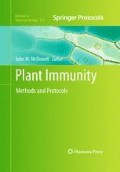Abstract
The haustorium is a distinguishing feature of biotrophic plant pathogens. Several highly diverged pathogen classes have independently evolved haustoria, suggesting that they represent an effective adaptation for growing within living plant tissue. Despite their clear importance in biotrophy, they have been difficult to study due to the close association of biotrophic pathogens with their host and the inability to produce haustoria in vitro. These drawbacks have been circumvented in the study of rust fungi by the development of a haustoria isolation technique. The strong binding of the lectin concanavalin A (ConA) to rust haustoria allows these structures to be purified from infected plant tissue by affinity chromatography on a ConA–Sepharose macrobead column. The isolation process results in substantial yields of intact haustoria that retain their cytoplasmic contents, making them amenable to experimentation. The construction of cDNA libraries from isolated rust haustoria and their subsequent sequence analysis have provided significant insight into haustoria function at a molecular level, revealing important roles in nutrient acquisition and the delivery of pathogenicity effector proteins. The generation of a rust haustorium-specific cDNA library is described in this chapter.
Access this chapter
Tax calculation will be finalised at checkout
Purchases are for personal use only
References
Harder, D. E. (1989) Rust haustoria – past, present, future. Can. J. Plant Pathol. 11, 91–99.
Voegele, R. T. and Mendgen, K. (2003) Rust haustoria: nutrient uptake and beyond. New Phytol. 159, 93–100.
Heath, M. C. (1997) Signalling between pathogenic rust fungi and resistant or susceptible host plants. Ann. Bot. 80, 713–720.
Panstruga, R. (2003) Establishing compatibility between plants and obligate biotrophic pathogens. Curr. Opin. Plant Biol. 6, 320–326.
Heath, M. C. (1989) In vitro formation of haustoria of the cowpea rust fungus, Uromyces vignae, in the absence of a living plant cell. I. Light microscopy. Physiol. Mol. Plant Pathol. 35, 357–366.
Heath, M. C. (1990) In vitro formation of haustoria of the cowpea rust fungus Uromyces vignae in the absence of a living plant cell. II. Electron microscopy. Can. J. Bot. 68, 278–287.
Voegele, R. T., Struck, C., Hahn, M. and Mendgen, K. (2001) The role of haustoria in sugar supply during infection of broad bean by the rust fungus Uromyces fabae. Proc. Natl Acad. Sci. U. S. A. 98, 8133–8138.
Struck, C., Ernst, M. and Hahn, M. (2002) Characterization of a developmentally regulated amino acid transporter (AAT1p) of the rust fungus Uromyces fabae. Mol. Plant Pathol. 3, 23–30.
Struck, C., Mueller, E., Martin, H. and Lohaus, G. (2004) The Uroymces fabae UfAAT3 gene encodes a general amino acid permease that prefers uptake of in planta scare amino acids. Mol. Plant Pathol. 5, 183–189.
Dodds, P. N., Lawrence, G. J., Catanzariti, A., Ayliffe, M. A. and Ellis, J. G. (2004) The Melampsora lini AvrL567 avirulence genes are expressed in haustoria and their products are recognized inside plant cells. Plant Cell 16, 755–768.
Kemen, E., Kemen, A. C., Rafiqi, M., Hempel, U., Mendgen, K., Hahn, M. and Voegele, R. T. (2005) Identification of a protein from rust fungi transferred from haustoria into infected plant cells. Mol. Plant Microbe Interact. 18, 1130–1139.
Catanzariti, A., Dodds, P. N., Lawrence, G. J., Ayliffe, M. A. and Ellis, J. G. (2006) Haustorially expressed secreted proteins from flax rust are highly enriched for avirulence elicitors. Plant Cell 18, 243–256.
Hahn, M. and Mendgen, K. (1992) Isolation by ConA binding of haustoria from different rust fungi and comparison of their surface qualities. Protoplasma 170, 95–103.
Murdoch, L. J., Kobayashi, I. and Hardham, A. R. (1998) Production and characterisation of monoclonal antibodies to cell wall components of the flax rust fungus. Eur. J. Plant Pathol. 104, 331–346.
Dekhuijzen, H. M. (1966) The isolation of haustoria from cucumber leaves infected with powdery mildew. Neth. J. Plant Pathol. 72, 1–11.
Gil, F. and Gay, J. L. (1977) Ultrastructural and physiological properties of the host interfacial components of haustoria of Erysiphe pisi in vivo and in vitro. Physiol. Plant Pathol. 10, 1–12.
Manners, J. M. and Gay, J. L. (1977) The morphology of haustorial complexes isolated from apple, barley, beet and vine. Physiol. Plant Pathol. 11, 261–266.
Hahn, M. and Mendgen, K. (1997) Characterization of in planta-induced rust genes isolated from a haustorium-specific cDNA library. Mol. Plant Microbe Interact. 10, 427–437.
Author information
Authors and Affiliations
Corresponding author
Editor information
Editors and Affiliations
Rights and permissions
Copyright information
© 2011 Springer Science+Business Media, LLC
About this protocol
Cite this protocol
Catanzariti, AM., Mago, R., Ellis, J., Dodds, P. (2011). Constructing Haustorium-Specific cDNA Libraries from Rust Fungi. In: McDowell, J. (eds) Plant Immunity. Methods in Molecular Biology, vol 712. Humana Press. https://doi.org/10.1007/978-1-61737-998-7_8
Download citation
DOI: https://doi.org/10.1007/978-1-61737-998-7_8
Published:
Publisher Name: Humana Press
Print ISBN: 978-1-61737-997-0
Online ISBN: 978-1-61737-998-7
eBook Packages: Springer Protocols

